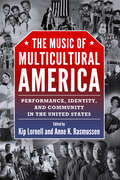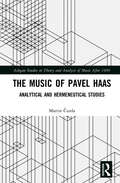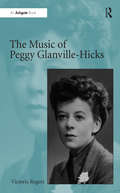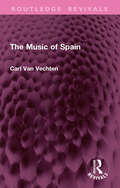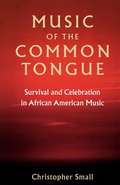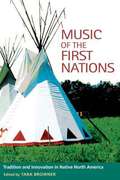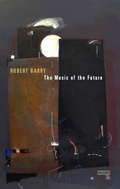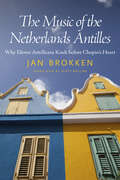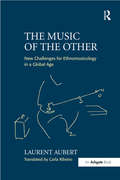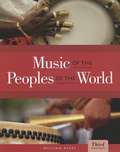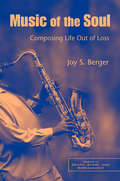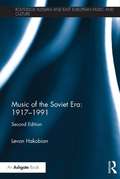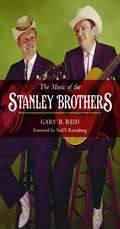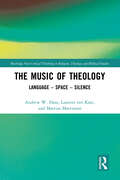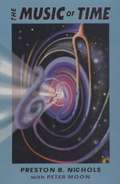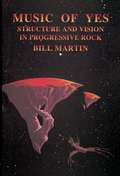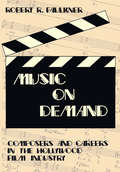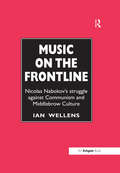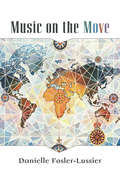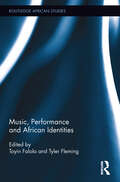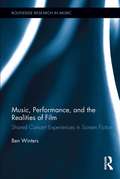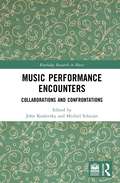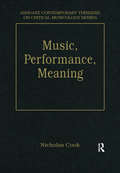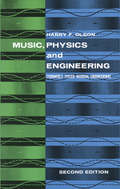- Table View
- List View
The Music of Multicultural America: Performance, Identity, and Community in the United States (American Made Music Series)
by Kip Lornell and Anne K. RasmussenThe Music of Multicultural America explores the intersection of performance, identity, and community in a wide range of musical expressions. Fifteen essays explore traditions that range from the Klezmer revival in New York, to Arab music in Detroit, to West Indian steel bands in Brooklyn, to Kathak music and dance in California, to Irish music in Boston, to powwows in the midwestern plains, to Hispanic and Native musics of the Southwest borderlands. Many chapters demonstrate the processes involved in supporting, promoting, and reviving community music. Others highlight the ways in which such American institutions as city festivals or state and national folklife agencies come into play. Thirteen themes and processes outlined in the introduction unify the collection's fifteen case studies and suggest organizing frameworks for student projects. Due to the diversity of music profiled in the book—Mexican mariachi, African American gospel, Asian West Coast jazz, women's punk, French-American Cajun, and Anglo-American sacred harp—and to the methodology of fieldwork, ethnography, and academic activism described by the authors, the book is perfect for courses in ethnomusicology, world music, anthropology, folklore, and American studies. Audio and visual materials that support each chapter are freely available on the ATMuse website, supported by the Archives of Traditional Music at Indiana University.
The Music of Pavel Haas: Analytical and Hermeneutical Studies (Ashgate Studies in Theory and Analysis of Music After 1900)
by Martin ČurdaThe Czech composer Pavel Haas (1899–1944) is commonly positioned in the history of twentieth-century music as a representative of Leoš Janáček’s compositional school and as one of the Jewish composers imprisoned by the Nazis in the concentration camp of Terezín (Theresienstadt). However, the nature of Janáček’s influence remains largely unexplained and the focus on the context of the Holocaust tends to yield a one-sided view of Haas’s oeuvre. The existing scholarship offers limited insight into Haas’s compositional idiom and does not sufficiently explain the composer’s position with respect to broader aesthetic trends and artistic networks in inter-war Czechoslovakia and beyond. This book is the first attempt to provide a comprehensive (albeit necessarily selective) discussion of Haas’s music since the publication of Lubomír Peduzzi’s ‘life and work’ monograph in 1993. It provides the reader with an enhanced understanding of Haas’s music through analytical and hermeneutical interpretation as well as cultural and aesthetic contextualisation, and thus reveal the rich nuances of Haas’s multi-faceted work which have not been sufficiently recognised so far.
The Music of Peggy Glanville-Hicks
by Victoria RogersPeggy Glanville-Hicks (1912-1990) is an Australian composer whose full significance has only recently been appreciated. Born in Melbourne, Australia, she transcended the gendered expectations of her upbringing and went on to become a fine composer and a highly influential figure in the vibrant musical life of New York after the Second World War. Following early composition studies with Fritz Hart in Melbourne, Glanville-Hicks moved to London where she studied with Ralph Vaughan Williams, then to Paris where she was taught by the great pedagogue, Nadia Boulanger. Her migration to the USA in 1941 shaped the musical direction of her late works. After a brief neoclassical phase, she joined the small group of American composers who were using non-Western musics as their inspirational well-spring, including Colin McPhee, Alan Hovhaness, Lou Harrison and Paul Bowles. During this period she also forged an illustrious career as a music journalist and arts administrator, working tirelessly to promote new music and the careers of young composers. In the late 1950s she retreated to Greece to write 'the big works', most notably the operas which lie at the heart of her creative output. Her compositional career ended prematurely, and tragically, in 1967 following surgery the previous year for a life-threatening brain tumour. Against all medical expectations she went on to live for a further 24 years, returning to Australia in 1975 amidst a dawning recognition that one of the country's most significant composers had returned. Glanville-Hicks's career as a composer is impressive by any measure. She produced over 70 finely-crafted works, including operas, ballets, concertos, instrumental chamber pieces, songs and choral works. The story of her life has been told in the biographies. This book traces the development of her musical language from the English pastoral style of the early works, through the neoclassicism of the middle period, to the melody-rhythm concept of the late works,
The Music of Spain (Routledge Revivals)
by Carl Van VechtenFirst published in 1920, The Music of Spain deals with historical periods, schools and style and appears to embrace everything related to music provided it affects or is affected by Spain in some degree, no matter how small or insignificant. The period extends from the sixteenth century to the early twentieth century and the author encircles his subject in a huge ring or parenthesis that opens with Antonio Cabezon, the Spanish Bach (according to Pedrell) and closes with the gypsy dancer and singer Pastora Imperio, queen of the Spanish “varieties” stage of today. It brings themes like Spain and music; the land of joy; and from George Borrow to Mary Garden. This book is an important historical reference for students and scholars of history of music, Spanish music.
Music of the Common Tongue: Survival and Celebration in African American Music (Music Culture)
by Christopher SmallIn clear and elegant prose, Music of the Common Tongue, first published in 1987, argues that by any reasonable reckoning of the function of music in human life the African American tradition, that which stems from the collision between African and European ways of doing music which occurred in the Americas and the Caribbean during and after slavery, is the major western music of the twentieth century. In showing why this is so, the author presents not only an account of African American music from its origins but also a more general consideration of the nature of the music act and of its function in human life. The two streams of discussion occupy alternate chapters so that each casts light on the other. The author offers also an answer to what the Musical Times called the "seldom posed though glaringly obtrusive" question: "why is it that the music of an alienated, oppressed, often persecuted black minority should have made so powerful an impact on the entire industrialized world, whatever the color of its skin or economic status?"
Music of the First Nations: Tradition and Innovation in Native North America (Music in American Life)
by Tara BrownerThis unique anthology presents a wide variety of approaches to an ethnomusicology of Inuit and Native North American musical expression. Contributors include Native and non-Native scholars who provide erudite and illuminating perspectives on aboriginal culture, incorporating both traditional practices and contemporary musical influences. Gathering scholarship on a realm of intense interest but little previous publication, this collection promises to revitalize the study of Native music in North America, an area of ethnomusicology that stands to benefit greatly from these scholars' cooperative, community-oriented methods. Contributors are T. Christopher Aplin, Tara Browner, Paula Conlon, David E. Draper, Elaine Keillor, Lucy Lafferty, Franziska von Rosen, David Samuels, Laurel Sercombe, and Judith Vander.
The Music of the Future
by Robert BarryThe Music of the Future is not a book of predictions or speculations about how to save the music business or the bleeding edge of technologies. Rather, it's a history of failures, mapping 200 years of attempts by composers, performers and critics to imagine a future for music. Encompassing utopian dream cities, temporal dislocations and projects for the emancipation of all sounds, The Music of the Future is in the end a call to arms for everyone engaged in music: "to fail again, fail better."
The Music of the Netherlands Antilles: Why Eleven Antilleans Knelt before Chopin's Heart (Caribbean Studies Series)
by Jan BrokkenThe Music of the Netherlands Antilles: Why Eleven Antilleans Knelt before Chopin's Heart is not your usual musical scholarship. In October 1999, eleven Antilleans attended the service held to commemorate the 150th anniversary of Frédéric Chopin's death. This service, held in the Warsaw church where the composer's heart is kept in an urn, was an opportunity for these Antilleans to express their debt of gratitude to Chopin, whose influence is central to Antillean music history. Press coverage of this event caused Dutch novelist and author Jan Brokken (b. 1949) to start writing this book, based on notes he took while living on Curaçao from 1993 to 2002. Anyone hoping to discover an overlooked chapter of Caribbean music and music history will be amply rewarded with this Dutch-Caribbean perspective on the pan-Caribbean process of creolization. On Curaçao, the history and legacy of slavery shaped culture and music, affecting all the New World. Brokken's portraits of prominent Dutch Antillean composers are interspersed with cultural and music history. He puts the Dutch Caribbean's contributions into a broader context by also examining the nineteenth-century works by pianist Louis Moreau Gottschalk from New Orleans and Manuel Saumell from Cuba. Brokken explores the African component of Dutch-Antillean music—examining the history of the rhythm and music known as tambú as well as American jazz pianist Chick Corea's fascination with the tumba rhythm from Curaçao. The book ends with a discussion of how recent Dutch-Caribbean adaptations of European dance forms have shifted from a classical approach to contemporary forms of Latin jazz.
The Music of the Other: New Challenges for Ethnomusicology in a Global Age
by Laurent AubertWe are surrounded by new musical encounters today as never before, and the experience of musics from elsewhere is progressively affecting all arenas of the human conscience. Yet why is it that Western listeners expect a certain cultural and ethnic 'authenticity' or 'otherness' from visiting artists in world music, while contemporary musicians in Western music are no longer bound by such restraints? Should we feel uncomfortable when sacred rites from Asia or Africa are remade for Westerners as musical entertainment? As these thorny questions suggest, the great flood of world musics and of their agents into our most immediate cultural environment is not a simple matter of expanding global musical exchange. Instead, complex processes are at work involving the growth of intercontinental tourism, the development of new technologies of communication and our perceptions both of ourselves and of the new musical others now around us. Elegantly tracing the dimensions of these new musical encounters, Laurent Aubert considers the impact of world musics on our values, our habits and our cultural practices. His discussions of key questions about our contemporary music culture widen conventional ethnomusicological perspectives to consider not only the nature of Western society as a 'global village' but also the impact of current Western demands on the future of world musics and their practitioners.
Music of the Peoples of the World (Third Edition)
by William AlvesThis book emphasizes the necessity of understanding music and its culture, and draws on diverse perspectives to guide the student, including music theory, musicology and ethnomusicology.
Music of the Soul: Composing Life Out of Loss (Series in Death, Dying, and Bereavement)
by Joy S. BergerMusic of the Soul guides the reader through principles, techniques, and exercises for incorporating music into grief counseling, with the end goal of further empowering the grieving person. Music has a unique ability to elicit a whole range of powerful emotional responses in people - even so far as altering or enhancing one's mood - as well as physical reactions. This interdisciplinary text draws in equal parts from contemporary grief/loss theory, music therapy research, historical examples of powerful music, case studies, and both self-reflecting and teaching exercises. Music is as much about beginnings as endings, and thus the book moves through life’s losses into its new beginnings, using musical expression to help the bereaved find meaning in loss and hurt, and move forward with their lives. With numerous exercises and examples for implementing the use of music in grief counseling, the book offers a practical and flexible approach to a broad spectrum of mental health practitioners, from thanatologists to hospice staff, at all levels of professional training and settings.
Music of the Soviet Era: 2nd Edition (Routledge Russian and East European Music and Culture)
by Levon HakobianThis volume is a comprehensive and detailed survey of music and musical life of the entire Soviet era, from 1917 to 1991, which takes into account the extensive body of scholarly literature in Russian and other major European languages. In this considerably updated and revised edition of his 1998 publication, Hakobian traces the strikingly dramatic development of the music created by outstanding and less well-known, ‘modernist’ and ‘conservative’, ‘nationalist’ and ‘cosmopolitan’ composers of the Soviet era. The book’s three parts explore, respectively, the musical trends of the 1920s, music and musical life under Stalin, and the so-called ’Bronze Age’ of Soviet music after Stalin’s death. Music of the Soviet Era: 1917–1991 considers the privileged position of music in the USSR in comparison to the written and visual arts. Through his examination of the history of the arts in the Soviet state, Hakobian’s work celebrates the human spirit’s wonderful capacity to derive advantage even from the most inauspicious conditions.
The Music of the Stanley Brothers (Music in American Life)
by Gary B. Reid Neil V. RosenbergThe Music of the Stanley Brothers brings together forty years of passionate research by scholar and record label owner Gary Reid. A leading authority on Carter and Ralph Stanley, Reid augments his own vast knowledge of their music with interviews, documents ranging from books to folios sold by the brothers at shows, and the words of Ralph Stanley, former band members, guest musicians, session producers, songwriters, and bluegrass experts. The result is a reference that illuminates the Stanleys' art and history. It is all here: dates and locations; the roster of players on well-known and obscure sessions alike; master/matrix and catalog/release numbers, with reissue information; a full discography sorting out the Stanleys' complex recording history; the stories behind the music; and exquisitely informed biographical notes that place events in the context of the brothers' careers and lives. Monumental and indispensable, The Music of the Stanley Brothers provides fans and scholars alike with a guide for immersion in the long career and breathtaking repertoire of two legendary American musicians.
The Music of Theology: Language – Space – Silence (Routledge New Critical Thinking in Religion, Theology and Biblical Studies)
by Andrew Hass Mattias Martinson Laurens ten KateThis book reconceives theology as a musical endeavour in critical tension with language, space and silence. An Overture first moves us from music to religion, and then from theology back to music – a circularity that, drawing upon history, sociology, phenomenology, and philosophy, disclaims any theology of music and instead pursues the music in theology. The chapters that follow explore the three central themes by way of theory, music and myth: Adorno, Benjamin and Deleuze (language), Derrida, Rosa and Nancy (space), Schelling/Hegel, Homer and Cage (silence). In overdubbing each other, these chapters work towards theology as a sonorous rhythm between loss and freedom. A Coda provides three brief musical examples – Thomas Tallis, György Ligeti, and Evan Parker – as manifestations of this rhythm, to show in summary how music becomes the very pulse of theology, and theology the very intuition of music. The authors offer an interdisciplinary engagement addressing fundamental questions of the self and the other, of humanity and the divine, in a deconstruction of modern culture and of its bias towards the eye over the ear. The book harmonizes three scholarly voices who attempt to find where the resonance of our Western conceptions and practice, musically and theologically, might resound anew as a more expansive music of theology.
The Music of Time
by Preston B. NicholsFor the first time, Preston reveals his employment at Brookhaven Labs and how his connections in the music industry were used for mind control and manipulation of the masses. Ultimately, Preston's real-life adventures lead to time travel, his own role in the future, and the efforts of his adversaries to arrest him and put him permanently out of commission. This includes the bone chilling story of John Ford, Preston's colleague, who is locked up without a trial for his own efforts to expose the truth. In a remarkable twist of fate, mysterious forces rescue Preston and begin a documented investigation and eventual conviction of the most politically powerful man on Long Island. This book reveals more layers of mystery in mankind's epic quest to understand the paradox of time and the imprisonment of consciousness.
Music of Yes
by Bill Martin Jr.Unlike most books on rock music, Music of Yes does not focus on personalities, but instead on musical structures, lyrical vision, and cultural and historical context. Bill Martin situates one of the most creative groups from the progressive rock period, Yes, within the utopian ideals of the sixties and the experimental trend in rock music initiated by the Beatles and taken up by groups such as King Crimson, Jethro Tull, Pink Floyd, and others. Working against the seemingly entrenched cynicism and "blues orthodoxy" among rock music critics, Martin demonstrates the power of Yes's romantic, utopian, "Blakean," ecological, multicultural, and feminist perspective, showing how this vision is developed through extended musical works."I think this book will stand out as the most definitive study of Yes, and anyway, how could I not like a book that compares my ability to that of John Coltrane and Jimi Hendrix?"-Chris Squire Co-founder of Yes"Yes fans will flock to this paean to the world of 1960s 'art rock'. . . Martin's points about the artistic aspirations of '60s and '70s 'progressive' music are thought-provoking." -Booklist
Music on Demand: Composers and Careers in the Hollywood Film Industry
by Robert R. FaulknerIn this remarkable study, Robert R. Faulkner shows that the Hollywood film industry, like most work communities, is dominated by a highly productive and visible elite who exercise major influence on the control of available resources, career chances, and access to opportunity. Faulkner traces a network of connections that bind together filmmakers (employers) and composers (employees) and reveals how work is allocated among composers and the division of labor within the Hollywood film community, using statistical analysis and highly revealing personal interviews. One of the very first empirical studies in the ""new economic sociology,"" Music on Demand shows the dynamics of markets constituted by the interaction between buyers and artistic talent (the producers and directors of feature films) and the sellers of artistic talent (the composers of film scores).Faulkner's interviews with those composers considered to be elite and those on the industry's periphery reveal how they perceive their careers, how they define commercial artistic success, and how they establish, or try to establish, those vital connections with filmmakers. Now available in paperback, this pioneering study will be of compelling interest to researchers in culture studies as well as readers interested in learning more about this little-known world.
Music on Martha's Vineyard: A History of Harmony (Music Ser.)
by Thomas Dresser Jerold MuskinMartha's Vineyard has a rich musical legacy that stretches back to the earliest drumbeats of the Wampanoags and the whaling chanteys of the nineteenth century. Returning Civil War veterans formed the island's oldest continuous music ensemble, the Vineyard Haven Band. Vineyarders embrace all things musical, from choral and string ensembles to singers and songwriters. Discover this melodious history from the early twentieth-century dance bands at the Tivoli ballroom, through the war years, the piano bars and the nascent folk music scene at the Mooncusser Cafe, where Carly Simon and James Taylor played their first licks. Authors Thomas Dresser and Jerry Muskin explore the homegrown music scene and the summer stars who keep islanders and visitors moving to the beat.
Music on the Frontline: Nicolas Nabokov's Struggle Against Communism and Middlebrow Culture
by Ian WellensThe story of Nicolas Nabokov's involvement with the CIA-funded Congress for Cultural Freedom (CCF) is a story of the politics and sociology of culture; how music was used for political ends and how intellectual groups formed and functioned during the Cold War. The seemingly independent CCF, established to counteract apparent Soviet successes in the fields of the arts and intellectual life, appointed Nabokov (a Russian emigre and minor composer) as its Secretary General in 1951.Over the next ten years he gave music a high profile in the work of the organisation, producing four international musical festivals, the first and most ambitious of which was 1952's L'Oeuvre du XXe siècle in Paris, an event which showcased the work of no less than 62 composers. As Ian Wellens reveals, Nabokov's musical involvement with the CCF was in fact a struggle on two fronts.Apparently a defence of Western modernism against 'backward', 'provincial' Soviet music, Nabokov's writings show this to have meshed closely with the domestic concern- shared by many intellectuals -that high culture was being undermined by an increasingly culturally aware middle class. His attacks on Soviet cultural policy, and his unflattering assessments of Shostakovich, are seen to be not merely salvos in the cold war but part of a broader campaign aimed at securing the authority and prestige of intellectuals.
Music on the Move
by Danielle Fosler-LussierMusic is a mobile art. When people move to faraway places, whether by choice or by force, they bring their music along. Music creates a meaningful point of contact for individuals and for groups; it can encourage curiosity and foster understanding; and it can preserve a sense of identity and comfort in an unfamiliar or hostile environment. As music crosses cultural, linguistic, and political boundaries, it continually changes. While human mobility and mediation have always shaped music-making, our current era of digital connectedness introduces new creative opportunities and inspiration even as it extends concerns about issues such as copyright infringement and cultural appropriation. With its innovative multimodal approach, Music on the Move invites readers to listen and engage with many different types of music as they read. The text introduces a variety of concepts related to music’s travels—with or without its makers—including colonialism, migration, diaspora, mediation, propaganda, copyright, and hybridity. The case studies represent a variety of musical genres and styles, Western and non-Western, concert music, traditional music, and popular music. Highly accessible, jargon-free, and media-rich, Music on the Move is suitable for students as well as general-interest readers.
Music, Performance and African Identities (Routledge African Studies)
by Toyin Falola Tyler FlemingCutting across countries, genres, and time periods, this volume explores topics ranging from hip hop’s influence on Maasai identity in current day Tanzania to jazz in Bulawayo during the interwar years, using music to tell a larger story about the cultures and societies of Africa.
Music, Performance, and the Realities of Film: Shared Concert Experiences in Screen Fiction (Routledge Research in Music)
by Ben WintersThis book examines the relationship between narrative film and reality, as seen through the lens of on-screen classical concert performance. By investigating these scenes, wherein the performance of music is foregrounded in the narrative, Winters uncovers how concert performance reflexively articulates music's importance to the ontology of film. The book asserts that narrative film of a variety of aesthetic approaches and traditions is no mere copy of everyday reality, but constitutes its own filmic reality, and that the music heard in a film's underscore plays an important role in distinguishing film reality from the everyday. As a result, concert scenes are examined as sites for provocative interactions between these two realities, in which real-world musicians appear in fictional narratives, and an audience’s suspension of disbelief is problematised. In blurring the musical experiences of onscreen observers and participants, these concert scenes also allegorize music’s role in creating a shared subjectivity between film audience and character, and prompt Winters to propose a radically new vision of music’s role in narrative cinema wherein musical underscore becomes part of a shared audio-visual space that may be just as accessible to the characters as the music they encounter in scenes of concert performance.
Music Performance Encounters: Collaborations and Confrontations (Routledge Research in Music)
by Michiel SchuijerWhy do most musical performers and musical researchers continue to inhabit divergent epistemic spaces? To what extent is the act of musical performance coextensive with the act of doing musical research, and vice versa? At what point in the research process can a performative act transform into a scholarly one, and a scholarly act into a performative one? These, and other related questions, form the central focus of this book, with each chapter offering a fresh perspective on a particular topic in music performance studies: improvisational traditions, historical performance practices, analysis and performance, sports psychology, cross-cultural musical interactions, and institutional challenges. This book is aimed at music researchers, teachers, students, and practising musicians interested in the intersection of academic and performance research; as such, it seeks to bridge the divide between the research of university-trained musicologists, scholars from other fields who focus on music, and the growing community of musical artist-researchers. Material in this book is supported by performance outcomes offered by the contributors on a separate YouTube channel and on the Routledge online portal.
Music, Performance, Meaning: Selected Essays (Ashgate Contemporary Thinkers On Critical Musicology Ser.)
by Nicholas CookThis selection of sixteen of Nicholas Cook's essays covers the period from 1987 to 2004 and brings out the development of the author's ideas over these years. In particular the two keywords of the title -Meaning and Performance- represent critical directions that expand to the point that, by the end of the book, they become coextensive: music is seen as social action and meaning as created by that action. Within this overall direction, a wide variety of topics is explored, ranging from Beethoven to Schenker, from Chinese qin music to jazz and rock, from perceptual psychology to sketch studies and analysis of record sleeves. A substantial introduction draws out the links (and differences) between the essays, sometimes critiquing them and always setting them into the developing context of the author's work as a whole.
Music, Physics and Engineering (Dover Books On Music Ser.)
by Harry F. OlsonNow thoroughly revised and enlarged, this book offers the most comprehensive coverage available of all aspects of the production, reception, and reproduction of sound. Written clearly and concisely, all its chapters can be understood without specialized training in music, physics, engineering, or mathematics.Dr. Olson discusses the nature of sound waves; explains the division of sound into scale patterns and the traditional method of notating them; describes the individual characteristics of all musical instruments currently in use (including the human voice); shows how the ears hear; discusses concert hall and recording studio acoustics, amplification systems, etc; describes the elements of sound reproduction systems from the telephone to the stereo record player; and concludes with a new chapter on the production, development, and potentialities of electronic music.Under these broad headings, readers will find a close analysis of the way in which a violin produces sound; descriptions of carbon, crystal, dynamic, velocity, and unidirectional microphones; a comparison of the relative absorbency of 22 acoustic materials, building materials, and objects; a description of how music can be produced by a digital computer; and much, much more. Conductors will find suggestions on positioning their orchestras; performers will understand the dynamics of their instruments; recording engineers and acousticians will discover a remarkably comprehensive reference work; and music teachers, students, physicists, and enthusiasts in general will find easy access to a vast wealth of information.
